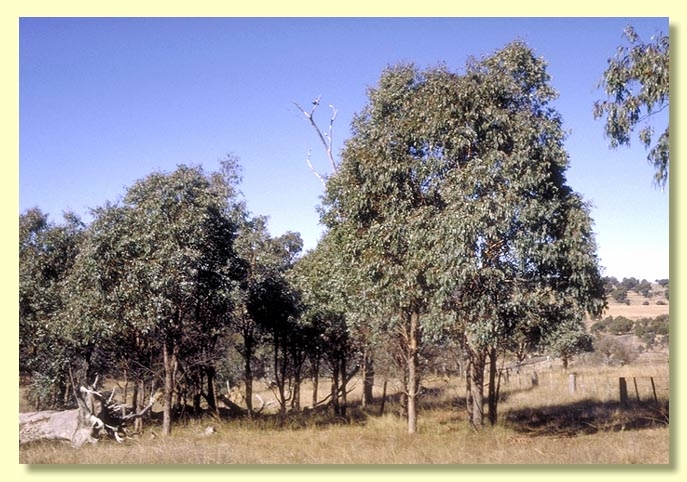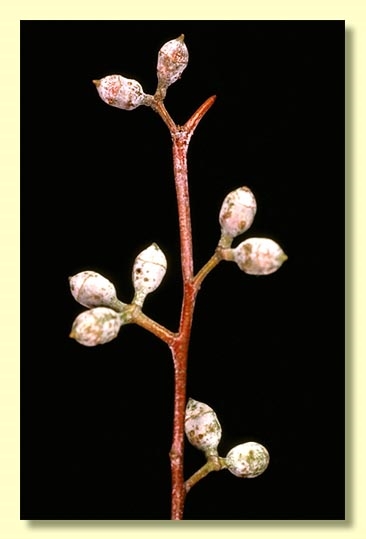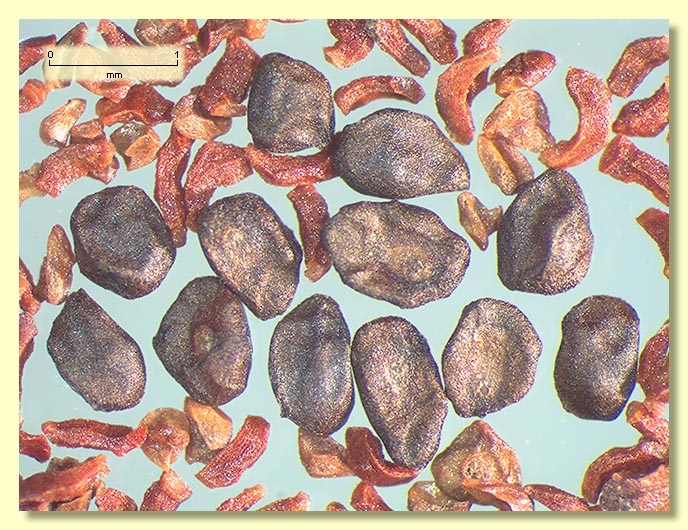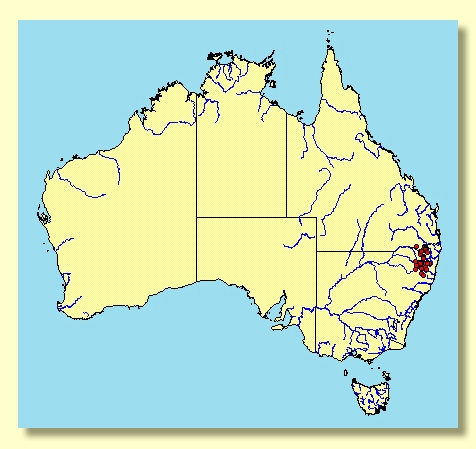Euclid - Online edition
Eucalyptus nova-anglica
Eucalyptus | Symphyomyrtus | Maidenaria | Euryotae | Argyrophyllae
Eucalyptus cinerea var. nova-anglica (H.Deane & Maiden) Maiden, Crit. Revis. Eucalyptus 3: 9 (1914). T: Moona Plains, Walcha, NSW, Sept. 1898, A.R.Crawford s.n.; lecto: NSW316904; fide Bean, A.R., Telopea 12(4): 473-474 (2010).
Bark rough throughout or branches < 8 cm diameter smooth; rough bark thick, fibrous, longitudinally furrowed, grey and red-brown.
Juvenile growth (coppice or field seedlings to 50 cm): stem rounded in cross-section, glaucous, warty, or smooth; juvenile leaves opposite, sessile, orbicular to cordate, 4–6 cm long, 3.5–6.5 cm wide, entire or crenulate, glaucous.
Adult leaves alternate, petiole 1.5–3.5 cm long; blade lanceolate, 9–19 cm long, 1.2–2.5 cm wide, flat or undulate, base tapering to petiole, concolorous, glossy or dull, green to blue-green, side-veins greater than 45° to midrib, densely reticulate, intramarginal vein parallel to and just within margin or remote from it, oil glands mostly island.
Inflorescence axillary unbranched, peduncles 0.5–1 cm long, buds 7 per umbel, pedicels 0.1–0.3 cm long. Mature buds ovoid to diamond-shaped, 0.4–0.5 cm long, 0.2–0.4 cm wide, green or glaucous, scar present, operculum conical, stamens inflexed or irregularly flexed, anthers cuboid to oblong, versatile, dorsifixed, dehiscing by longitudinal slits (non-confluent), style long, stigma blunt or tapered, locules 3 or 4, the placentae each with 4 vertical ovule rows. Flowers white.
Fruit on pedicels to 0.2 cm long, rarely sessile, hemispherical or obconical, 0.3–0.4 cm long, 0.3–0.6 cm wide, glaucous or non-glaucous, disc raised-convex to annular, valves 3 or 4, exserted.
Seeds dark brown or black, 1–2 mm long, ovoid or flattened-ovoid, usually lacunose, dorsal surface smooth or shallowly pitted, hilum ventral.
Cultivated seedlings (measured at ca node 10): cotyledons bilobed; stems rounded in cross-section, glaucous; leaves sessile, opposite for many pairs, orbicular to cordate, 2.5–4.5 cm long, 1.5–5 cm wide, base usually amplexicaul, rarely rounded or truncate, margin entire or subcrenulate, apex rounded to pointed, glaucous or blue-grey.
Flowering has been recorded in February, March, April and May.
A small to medium-sized tree from near Walcha on the Northern Tablelands of New South Wales on both granitic and basaltic soils extending into far south-eastern Queensland from Castle Rock (Qld) and Bald Rock (NSW) to north of Poziere.
E. nova-anglica is related to the well-known three-budded E. cinerea, which is easily distinguished by its crown of predominantly round to ovate, glaucous juvenile leaves, but is closer to E. cephalocarpa, which occurs almost exclusively in Victoria. Both E. cephalocarpa and E. nova-anglica have buds in sevens with the latter being distinctly pedicellate (usually sessile in E. cephalocarpa). The related E. alligatrix subsp. miscella, restricted to Rylstone New South Wales, has buds in threes and sevens on the same tree.
Eucalyptus nova-anglica belongs in Eucalyptus subgenus Symphyomyrtus section Maidenaria, a large group of species more or less restricted to south-eastern Australia, characterised by bilobed cotyledons, simple axillary inflorescences, buds with two opercula, stamens with versatile anthers and flattened seeds with a ventral hilum. Within this section, E. nova-anglica belongs in series Argyrophyllae having longitudinally furrowed fibrous rough bark throughout, orbicular or ovate juvenile leaves opposite for many nodes and small diamond-shaped buds in sevens. The four other species mentioned above complete the series.
E. nova-anglica may be confused with E. bridgesiana, which differs fundamentally in the juvenile leaves which are ovate and alternate, and crenulate.













